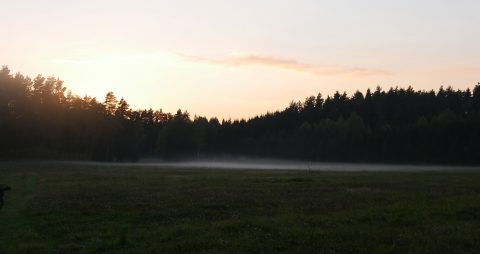In 2020 LOM awarded a Karla Roman Travel Bursary to architectural student Andreea Ciutac. Her trip was delayed due to the pandemic, but last autumn Andreea was finally able to realise her dream of travelling along Europe’s Iron Curtain from Berlin to Bucharest.
Andreea, who is now working as a Part II architectural assistant, and her partner, photographer Marco Verhoogt spent 33 days on the road. Travelling with only the necessary supplies, they undertook an epic 650km cycle ride along a central part of the historic Iron Curtain.
At the end of September 2021, Andreea and Marco arrived at their first destination – Germany’s capital city Berlin. Together they explored this once divided city – enjoying the museums and taking in the city’s architecture and building up a picture of the East-West separation. They took a 12-hour bus ride to the small village of Heidemuhle in the Bavarian Forest. This was their starting point on the Iron Curtain Trail. Also known as EuroVelo 13, it is a 9,950-kilometre-long cycle route that stretches from Finland to Turkey and covers 20 countries.
Together the pair cycled 650km along the Austrian-Czech border, travelling through the Bohemian Forest, the Bohemian-Moravian highlands and alongside the Morava River to Bratislava in Slovakia. They drove the final leg of the journey, following the Danube River from Bratislava to Budapest.
“Traveling by bike, through forested hills, on highways and along the Danube's shoreside, we had the opportunity to experience the landscape in a visceral way. We were confronted with both the effects of time on historical hotspots, as well as the rugged interactions that humans have with nature outside of urban environments. We are grateful for this opportunity and encourage future bursary applicants to plan adventurously.”
Andreea Cuitac, 2020 travel bursary recipient
The trip was full of contrasts, and Marco was particularly struck by the friction between natural landscapes and human intervention. He explains: “We spent much of our time in the forest. This was interesting not only because countries faded seamlessly into one another, but also because the points of contact between the natural landscape and people were much more apparent and aggressive”. Untouched for 50 years, large areas of the curtain are now abundant with wildlife creating a greenbelt through central Europe. But this landscape has been altered by humans. Altered historically with structures like the nineteenth century Schwarzberg canal, and newer interventions such as the cycle route, and concerningly, evidence of intense deforestation.”
As a ‘landscape of historic memory’, Andreea recalls the different architectural typologies that she spotted along the route. There were many dilapidated guard towers and Second World War bunkers. Some of the bunkers have been repurposed as homes and so she and Marco stayed in a tiny house built on a bunker foundation for the night. They also came across crucifixes at crossroads which are there to bring travellers’ luck.
For Andreea and Marco, this was truly a fascinating and inspiring journey. They hope one day to travel another stretch of the Iron Curtain Trail. In the meantime, they are planning to turn their experience into a publication.
This trip was supported by the Karla Roman Travel Bursary, which is in memory of LOM colleague Karla Roman who tragically died while cycling to work in 2017. The bursary gives architecture students the opportunity to travel as part of their education or wider studies. For more information, visit the Travel Bursary page.
“This was clearly a trip of a lifetime for Andreea and Marco and gave them both new insight and valuable experiences that will live with them forever. It is a beautiful tribute to Karla Roman, who loved both cycling and travelling. We hope this journey inspires others to take on an adventure and consider applying for the 2022 bursary when LOM asks for applications in September.”
Richard Hutchinson, LOM director





